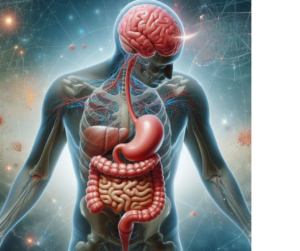A variety of stomach and gut health issues can significantly disrupt the digestive system, leading to discomfort and pain that ultimately detracts from one's quality of life. These conditions can range from irritable bowel syndrome to gastroesophageal reflux disease, peptic ulcers, inflammatory bowel disease, coeliac disease, diverticulitis, and gallstones. Each of these disorders presents unique symptoms and challenges, underscoring the importance of understanding their implications on gut health.
Table of Contents
ToggleUnderstanding Irritable Bowel Syndrome: Symptoms and Causes
Irritable bowel syndrome (IBS) is a chronic health condition that significantly affects gut health, leading to symptoms such as severe stomach pain, bloating, and alternating bouts of diarrhoea and constipation. The precise triggers for IBS can vary widely among individuals and may include factors such as genetic predisposition, dietary habits, prior gastrointestinal infections, inflammation of the gut lining, a condition often referred to as leaky gut, and an overgrowth of pathogenic bacteria within the gut microbiome. Understanding these triggers is crucial for effective management and treatment of IBS, as each person's experience with the disorder can differ considerably, requiring personalized approaches to dietary and lifestyle modifications.
Exploring Gastroesophageal Reflux Disease: Causes and Effects
Gastroesophageal reflux disease (GERD) is a chronic condition characterized by the frequent backflow of stomach acid into the esophagus, leading to uncomfortable symptoms such as persistent heartburn, regurgitation of food, and chest pain. If left untreated, GERD can lead to severe complications, including inflammation of the esophagus, known as Barrett’s esophagus, which significantly increases the risk of developing esophageal cancer. The underlying mechanism of GERD often involves a weakened sphincter, the tight muscular junction between the stomach and esophagus. Factors contributing to this weakening include improper stomach emptying, the presence of a hiatus hernia, obesity, smoking, and dietary choices such as the consumption of spicy, fatty, or acidic foods. Understanding these factors is essential for effective management and prevention strategies.
Additionally, certain lifestyle choices can exacerbate GERD symptoms. For instance, being overweight increases abdominal pressure, which can push stomach contents back into the esophagus. Smoking not only weakens the lower esophageal sphincter but also stimulates acid production in the stomach. Furthermore, dietary triggers like citrus fruits, caffeine, and alcohol can further aggravate this condition. Recognizing and modifying these behaviors can significantly improve quality of life for those suffering from GERD.
To effectively manage GERD, it is crucial to adopt a comprehensive approach that includes dietary modifications, maintaining a healthy weight, and avoiding known triggers. In some cases, medical treatment may be necessary to control symptoms and prevent complications. By understanding the factors contributing to GERD, individuals can take proactive steps toward improving their digestive health.
Identifying Peptic Ulcers: Symptoms and Risk Factors
Peptic ulcers are painful sores that develop in the lining of the stomach, esophagus, or small intestine, causing symptoms such as abdominal pain, bloating, nausea, vomiting, and unexpected weight loss. The primary causes of these ulcers include an overgrowth of pathogenic bacteria, particularly Helicobacter pylori, which can lead to infection, prolonged use of nonsteroidal anti-inflammatory drugs (NSAIDs), excessive stomach acid production, and damage to the protective mucus layer that shields the digestive tract. Lifestyle factors such as smoking and excessive alcohol consumption further exacerbate these painful sores.
Understanding Inflammatory Bowel Disease: Symptoms and Risk Factors
Inflammatory bowel disease (IBD) refers to chronic inflammation of the gut, primarily associated with conditions like Crohn’s disease and ulcerative colitis. This condition manifests through symptoms such as persistent abdominal pain, diarrhea, unexplained weight loss, and fatigue. IBD is often linked with a family history of autoimmune diseases, and although there is no cure, managing this condition is crucial due to the increased risk of developing bowel cancer. The inflammation can damage the protective mucus layer of the gut, leading to increased permeability, which allows toxins and bacteria to enter the bloodstream. This process can cause systemic pain, infections, and further inflammation, significantly impacting overall health and quality of life.
Exploring Coeliac Disease: Symptoms and Management
Coeliac disease is an autoimmune disorder triggered by the consumption of gluten, a protein found in grains like wheat, barley, and rye. When individuals with coeliac disease consume gluten, it leads to significant damage to the lining of the gut, which can severely impact nutrient absorption. Common symptoms associated with coeliac disease include foul-smelling diarrhea, bloating, excessive flatulence, indigestion, and constipation, all of which can contribute to severe abdominal pain. A family history of coeliac disease or other autoimmune conditions increases the risk of developing this disorder, highlighting the need for early diagnosis and strict adherence to a gluten-free diet to mitigate symptoms and promote gut health.
Individuals diagnosed with coeliac disease must avoid gluten-containing foods to prevent damage to the intestines. This necessitates a comprehensive understanding of food labels and dietary choices, making it imperative for those affected to educate themselves about gluten sources and suitable alternatives. A gluten-free diet, when adhered to, can significantly improve symptoms and enhance overall well-being, allowing individuals to lead healthier lives.
Understanding Diverticulitis: Causes and Symptoms
Diverticulitis occurs when small pouches called diverticula form along the walls of the large intestine. When food particles get trapped in these pouches, they can become inflamed and infected, leading to diverticulitis. Symptoms often include bloating and discomfort in the lower abdomen. In more severe cases, individuals may experience intense abdominal pain, fever, and chronic diarrhea, necessitating immediate medical attention. The primary risk factors for developing diverticulitis include a low-fiber diet, obesity, a sedentary lifestyle, and smoking. Increasing fiber intake, maintaining a healthy weight, and engaging in regular physical activity are essential strategies for preventing this condition and promoting gut health.
Gallstones: Causes, Symptoms, and Management
Gallstones, though not located in the stomach or gut, can cause excruciating pain in the upper abdomen. These stones form from hardened cholesterol, bile, and bilirubin, leading to small stone formations in the gallbladder. They can range in size from a grain of sugar to that of a small ball, such as a golf ball or ping pong ball. Symptoms may include nausea and vomiting. Risk factors for developing gallstones include age (particularly over 40), female gender, obesity, diabetes, and a family history of gallstones. A diet low in fiber and high in processed foods can further elevate the risk of gallstone formation, making dietary management essential for prevention and treatment.
Effective Strategies for Preventing Common Gut and Stomach Problems

<div class="elementor-element elementor-element-c58bdd5 e-flex e-con-boxed e-con
